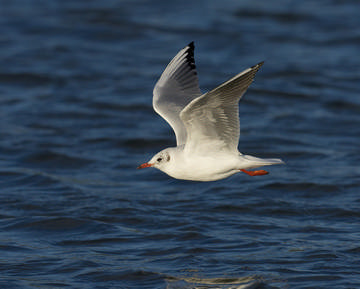
Black-headed Gull © Richard Steel
Black-headed Gull is the most widespread gull in winter, being found in almost three-quarters of the county’s tetrads, and seen flying over almost all of them. They avoid the highest land in the eastern hills, and there is a noticeable gap around the environs of Manchester Airport in SJ88, perhaps showing the effects of the airport’s bird-scaring manoeuvres. Not only is it the most widespread gull, it is also the most numerous, found in by far the largest flocks. The median flock size was 60 birds and fieldworkers made 288 counts of 100 or more, and 43 counts of 1,000 or more Black-headed Gulls. The largest gatherings were on water, observers reporting loafing or roosting flocks of 20,000 at Hurleston reservoir (SJ65H), 12,000 on Doddington Pool (SJ74D) and a regular roost of 10,000 birds on mudflats in the river Mersey after feeding at the Arpley landfill site (SJ58T/ Y).
Some three-quarters of the wintering population are immigrants. There are movements of ringed Black-headed Gulls between Cheshire and Wirral and breeding grounds in every country around the North Sea, with the most distant over 1000 km inland in Russia, halfway between Moscow and the Black Sea. On the other hand, some locally-bred birds move out for the winter, with a Woolston-ringed chick wintering in Galway City on the west coast of Ireland.
They feed on a wide variety of soil invertebrates, carrion and marine invertebrates taken in intertidal areas, and domestic waste. 58% of the habitat records submitted for this survey were farmland, with 9% in human sites, 20% on freshwater and 9% in marine areas. Most of the farmland habitats were grassland (42%), with 15% on tilled land or stubble.
They have obviously changed their habits considerably over the years. Until late in the 19th century Black-headed Gulls were almost entirely a coastal bird (BTO Winter Atlas). Coward (1910) commented on their remarkable increase inland, most notably in the north of the county next to the line of the newly-constructed Manchester Ship Canal, which gulls followed along its length. It was worth mentioning that, after 1900, Rostherne Mere had become a regular roosting place for hundreds of birds. Bell (1962) noted that the species was abundant and widespread inland, with ‘a vast roost’ around Runcorn on the Mersey estuary and major roosts at Rostherne, Doddington, and Witton flashes. The Rostherne roost was estimated at 10-12,000 in February 1962 (Bell 1967).
Sponsored by Hazel J. Raw

